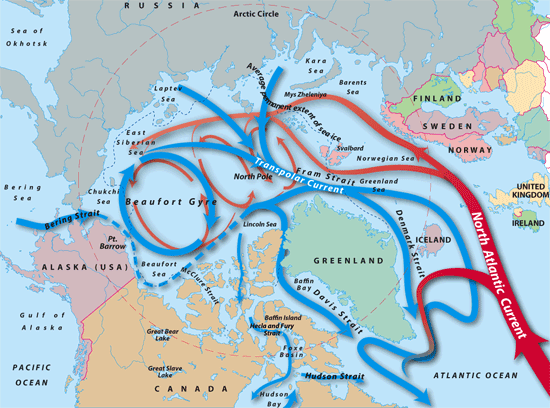Spring ice clogs up the Bering Strait, via George Riggs, NASA GSFC
As much as we worry about climate change today, a warm, melted Arctic was actually a dream of geo-engineers since at least the 19th century. But at the height of the Cold War, a Soviet scientist named Petr Mikhailovich Borisov proposed what may be the most ambitious Arctic-melting project ever conceived: a dam spanning the 55-mile-long Bering Strait that would be big enough to redirect the currents of the world’s oceans and force warming water to melt the Arctic Ocean forever.
Videos by VICE
As the warm Gulf Stream turns into the North Atlantic Current on its path towards the Arctic Circle, it gradually loses heat as it’s bombarded by cold flows heading south from the ice. It eventually cools down completely, powered along by cold Pacific streams heading through the Bering Strait before it turns back around, as shown in the offset figure below.
Borisov thus posited that if the cold influx of waters from the Pacific were reversed, the cold layer of low-salinity, Arctic surface water could be replaced by the Gulf Stream’s warm, salty waters that would be harder to freeze. It would also be self-sustaining, for Borisov argued that as the reflective ice melted, Arctic waters would absorb more heat and never freeze again.

Click to enlarge. Image: Jack Cook, Woods Hole Oceanographic Institute
It’s important to note that Borisov wasn’t a mad scientist or anything of that sort, and his work was of interest to the Soviet government, which was already funding a wide range of research looking to warm the Arctic. It was all aimed at solving a simple problem: Russia is too damn cold.
You might laugh, but while Soviet Russia was blessed with the largest land mass of any nation on Earth, much of it resource rich, putting that land to use was stunningly difficult. Currently about 63 percent of Russia is buried under permafrost, and as the CIA World Factbook notes, even today it is a significant barrier to development of Siberia.
Russia was already spending an enormous amount of money combating the ice. Exploiting the vast petroleum reserves of the Arctic and Siberia was crucial to the growth of the Soviet economy, with every well-pitted far-flung man against frozen earth and wind.
The fight was against the sea itself as well. In the late 50s, around the time that Borisov proposed his dam, the USSR launched NS Lenin, the first nuclear-powered icebreaker, and the first nuclear-powered civilian ship. That on its own was a leap forward, and led to the creation of the largest nuclear icebreaker fleet ever created.
So in the middle of the Cold War, the Soviet Union found itself trying to pit its land and resource advantage against the more temperate climate of the United States. With space and the atom already having been harnessed, why not the world’s oceans? Why not the weather itself?
Regardless of all the negative aspects of the Cold War, it fueled—and was fueled by—an enormous amount of scientific innovation. With the whole world in play, both the US and the Soviet Union were looking for developments on a global scale, which means scientists with outsized ideas were able to find equally outsized budgets. In the Soviet Union, that type of environment sent the first satellite, animal, and man into orbit; it also funded the research that led to the Tsar Bomba, the most powerful nuclear bomb ever detonated. (The US, meanwhile, was using nuclear bombs as enormous shovels.)
More
From VICE
-

Screenshot: Epic Games -

(Matan Chocron / Israel Antiquities Authority) -

Amouranth -

Screenshot: Gearbox Publishing